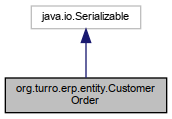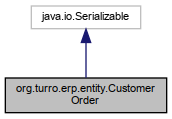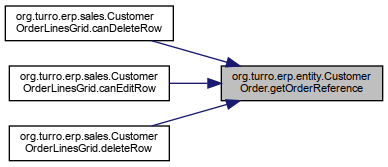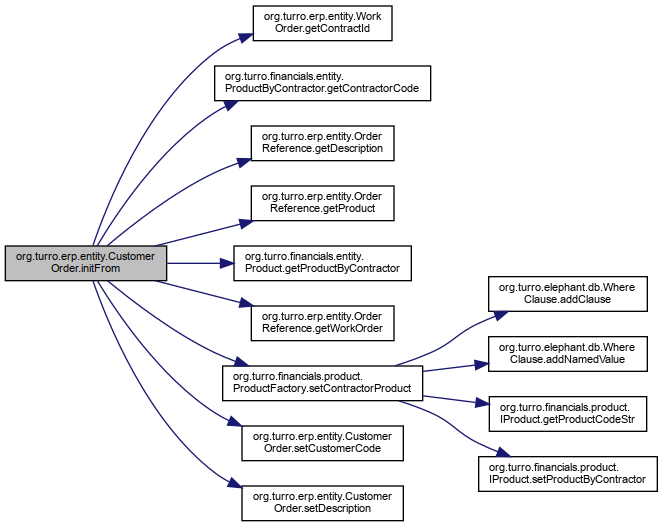◆ getAmount()
| double org.turro.erp.entity.CustomerOrder.getAmount |
( |
| ) |
|
◆ getControlDate()
| Date org.turro.erp.entity.CustomerOrder.getControlDate |
( |
| ) |
|
◆ getCustomer()
| Contract org.turro.erp.entity.CustomerOrder.getCustomer |
( |
| ) |
|
Definition at line 230 of file CustomerOrder.java.
231 return new DaoEntity<Contract, Long>() {
233 protected Dao createDao() {
234 return new FinancialsPU();
237 protected boolean shouldLog() {
◆ getCustomerCode()
| String org.turro.erp.entity.CustomerOrder.getCustomerCode |
( |
| ) |
|
◆ getCustomerId()
| long org.turro.erp.entity.CustomerOrder.getCustomerId |
( |
| ) |
|
◆ getDelivery()
| Date org.turro.erp.entity.CustomerOrder.getDelivery |
( |
| ) |
|
◆ getDescription()
| String org.turro.erp.entity.CustomerOrder.getDescription |
( |
| ) |
|
◆ getId()
| long org.turro.erp.entity.CustomerOrder.getId |
( |
| ) |
|
◆ getOrderDate()
| Date org.turro.erp.entity.CustomerOrder.getOrderDate |
( |
| ) |
|
◆ getOrderId()
| String org.turro.erp.entity.CustomerOrder.getOrderId |
( |
| ) |
|
◆ getOrderReference()
| OrderReference org.turro.erp.entity.CustomerOrder.getOrderReference |
( |
| ) |
|
Definition at line 197 of file CustomerOrder.java.
201 return (OrderReference)
new ErpPU().getSingleResultOrNull(
202 "select o from OrderReference as o " +
203 "where o.customerOrder = ?",
204 new Object[] {
this });
◆ getPrice()
| double org.turro.erp.entity.CustomerOrder.getPrice |
( |
| ) |
|
◆ getQuantity()
| double org.turro.erp.entity.CustomerOrder.getQuantity |
( |
| ) |
|
◆ getService()
| Contract org.turro.erp.entity.CustomerOrder.getService |
( |
| ) |
|
Definition at line 209 of file CustomerOrder.java.
210 return new DaoEntity<Contract, Long>() {
212 protected Dao createDao() {
213 return new FinancialsPU();
216 protected boolean shouldLog() {
◆ getServiceId()
| long org.turro.erp.entity.CustomerOrder.getServiceId |
( |
| ) |
|
◆ initFrom()
| void org.turro.erp.entity.CustomerOrder.initFrom |
( |
OrderReference |
orderReference | ) |
|
Definition at line 187 of file CustomerOrder.java.
189 if(orderReference.getProduct() !=
null) {
190 ProductFactory.setContractorProduct(orderReference.getProduct(), orderReference.getWorkOrder().getContractId());
191 if(orderReference.getProduct().getProductByContractor() !=
null) {
192 setCustomerCode(orderReference.getProduct().getProductByContractor().getContractorCode());
void setDescription(String description)
void setCustomerCode(String customerCode)
◆ isEmpty()
| boolean org.turro.erp.entity.CustomerOrder.isEmpty |
( |
| ) |
|
◆ isNoFraction()
| boolean org.turro.erp.entity.CustomerOrder.isNoFraction |
( |
| ) |
|
◆ isWantBudget()
| boolean org.turro.erp.entity.CustomerOrder.isWantBudget |
( |
| ) |
|
◆ setControlDate()
| void org.turro.erp.entity.CustomerOrder.setControlDate |
( |
Date |
controlDate | ) |
|
◆ setCustomer()
| void org.turro.erp.entity.CustomerOrder.setCustomer |
( |
Contract |
customer | ) |
|
Definition at line 243 of file CustomerOrder.java.
244 if(customer !=
null) {
245 customerId = customer.getId();
◆ setCustomerCode()
| void org.turro.erp.entity.CustomerOrder.setCustomerCode |
( |
String |
customerCode | ) |
|
◆ setCustomerId()
| void org.turro.erp.entity.CustomerOrder.setCustomerId |
( |
long |
customerId | ) |
|
◆ setDelivery()
| void org.turro.erp.entity.CustomerOrder.setDelivery |
( |
Date |
delivery | ) |
|
◆ setDescription()
| void org.turro.erp.entity.CustomerOrder.setDescription |
( |
String |
description | ) |
|
◆ setId()
| void org.turro.erp.entity.CustomerOrder.setId |
( |
long |
id | ) |
|
◆ setNoFraction()
| void org.turro.erp.entity.CustomerOrder.setNoFraction |
( |
boolean |
noFraction | ) |
|
◆ setOrderDate()
| void org.turro.erp.entity.CustomerOrder.setOrderDate |
( |
Date |
orderDate | ) |
|
◆ setOrderId()
| void org.turro.erp.entity.CustomerOrder.setOrderId |
( |
String |
orderId | ) |
|
◆ setPrice()
| void org.turro.erp.entity.CustomerOrder.setPrice |
( |
double |
price | ) |
|
◆ setQuantity()
| void org.turro.erp.entity.CustomerOrder.setQuantity |
( |
double |
quantity | ) |
|
◆ setService()
| void org.turro.erp.entity.CustomerOrder.setService |
( |
Contract |
service | ) |
|
Definition at line 222 of file CustomerOrder.java.
223 if(service !=
null) {
224 serviceId = service.getId();
◆ setServiceId()
| void org.turro.erp.entity.CustomerOrder.setServiceId |
( |
long |
service | ) |
|
◆ setWantBudget()
| void org.turro.erp.entity.CustomerOrder.setWantBudget |
( |
boolean |
wantBudget | ) |
|
The documentation for this class was generated from the following file:





